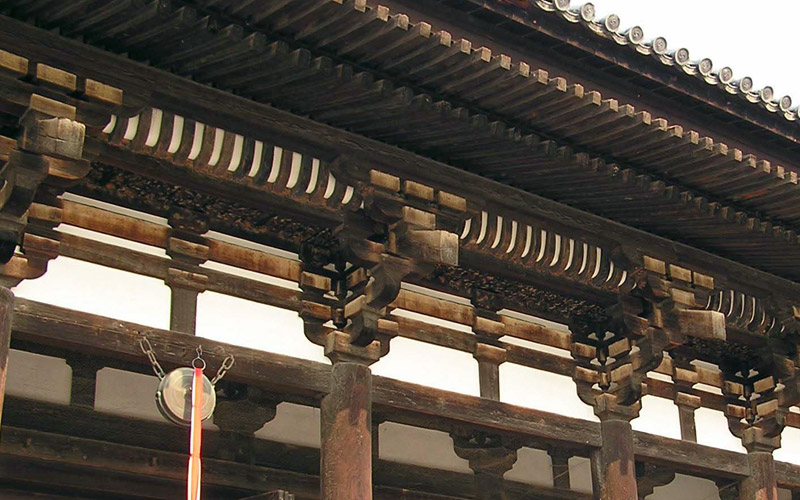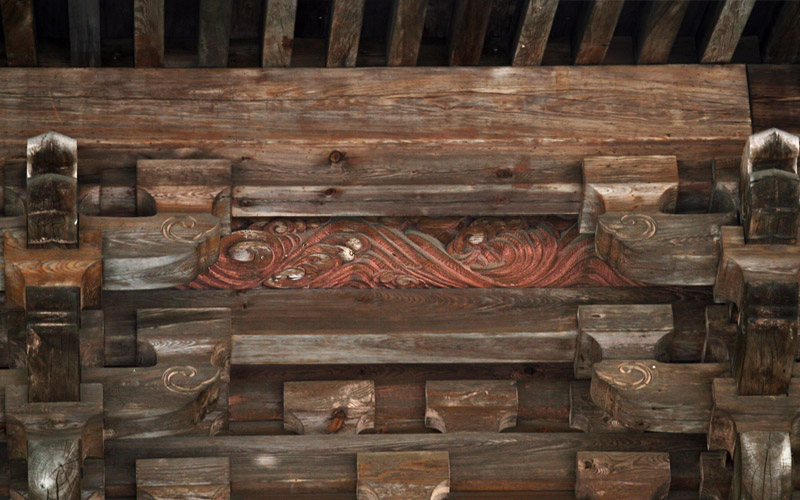| Also
written }Φ. A short, curved, non-supporting member that forms a diagonal
transition between two parallel horizontal beams; a purlin *keta
, and a bracket tie beam *tooshihijiki
ΚIΨ, or between two bracket tie beams set at slightly different levels.
Shirin may be straight, convex or concave. When used around an interior
ceiling, the shirin are either straight or concave and are often considered
part of the ceiling. When used on the exterior under the eaves of a building,
the shirin are convex. They form a neat transition between the beams,
and fill a space that would otherwise be an ugly gap that reveals rough
structural members. The basic type of shirin is called honshirin
{xΦ or *jabara shirin
Φ xΦ. The latter means shirin that give the impression of
being a cornice. It is composed of equally spaced ribs, shirinko
xΦq or ribs grouped in twos or threes, with the spaces between filled by
thin boards called shirin-ita xΦΒ. A common name for any style of
shirin placed under the eaves is *nokishirin
¬xΦ. The ribs are either square or rectangular in section. Some have a slight
curve at the top. An example of this type is found in Houryuuji *Kondou @²ΰ°
(rebuilt 693), Nara. An example, of straight, slanting
shirin is found in Toushoudaiji *Koudou ΅ρu° (8c) Nara. However,
shirin used from the late 7c through the 8c usually have a gentle
curve overall. When stepped bracket complexes are used, a shallow ceiling
*nokitenjou ¬Vδ,
and shirin are needed to fill the distance between the purlins and
eave ends *nokisaki
¬ζ. During the Heian period, the slant of the shirin, both inside
the building and outside beneath the eaves, was generally much more abrupt
than in previous centuries. On the interior the upper part of the shirin curves slightly while on the exterior, the lower part has a little curvature
and the upper part is straight. One exception are shirin found in Byoudouin *Hououdou ½@P° (1053), Kyoto. From the 13c, Zen style *zenshuuyou
T@l shirin became elaborate. *Hishishirin
HxΦ, have lozenge shape ribs with a curved board backing or a lozenge pattern
carved into the surface of the curved boards. There are many other types
of shirin ; Namishirin gxΦ (constructed in wave pattern), *kumoshirin
_xΦ (constructed in a cloud pattern), uzumaki shirin QͺxΦ (constructed in a spiral pattern), wachigai shirin ΦαxΦ (constructed
in a pattern of intersecting circles). Itashirin ΒxΦ are flat boards
which provide the backing for the patterns mentioned above. Coved ceilings
*oriage tenjou
άγVδ, are raised by an arrangement of coved ribs called oriage shirin
άγxΦ that spring from the wall plate *daiwa
δΦ, and are attached to the ceiling framing joists *goutenjou iVδ. |




